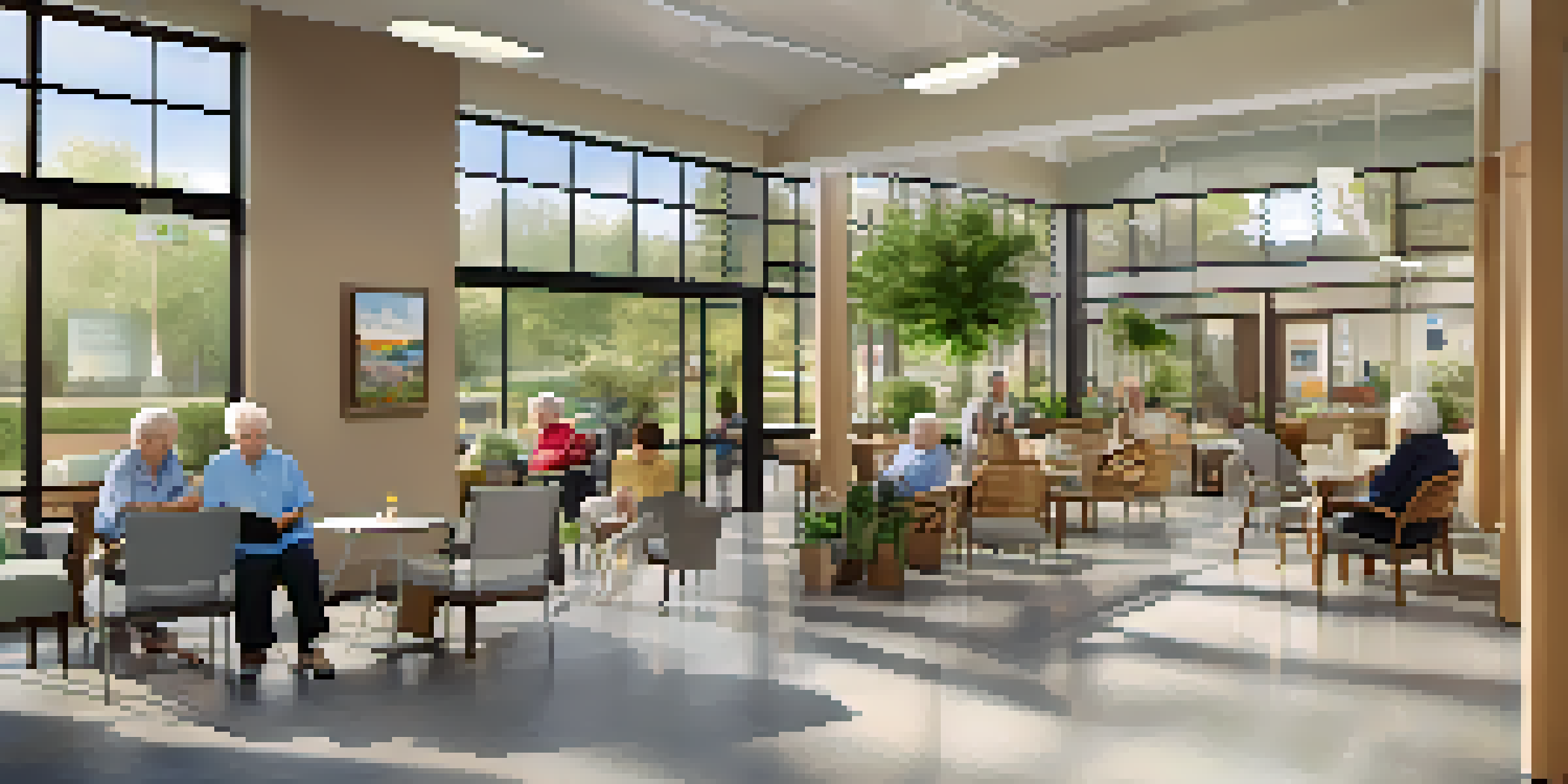Aging Populations: Equity Challenges in Healthcare Access

Understanding Aging Populations and Their Needs
As the global population ages, understanding the unique needs of older adults becomes crucial. This demographic often faces a variety of health challenges, from chronic diseases to mobility issues. Their healthcare needs require tailored solutions that recognize both medical and social factors. Ignoring these needs can lead to disparities in care and a lower quality of life for many seniors.
Aging is not lost youth but a new stage of opportunity and strength.
The aging population is not homogenous; it includes individuals from diverse backgrounds with varying levels of access to resources. This diversity means that solutions must be multifaceted and consider the specific circumstances of different groups. For instance, some older adults may have adequate financial resources, while others may struggle to afford basic healthcare services. Therefore, it’s essential to understand the broader context of aging to address these disparities effectively.
Moreover, as life expectancy increases, the healthcare system must adapt to provide comprehensive care that can keep pace with the evolving needs of older adults. This includes not only medical care but also preventive measures, mental health support, and social services. By embracing a holistic approach, we can better serve this growing segment of the population.
Barriers to Healthcare Access for Seniors
Many older adults encounter significant barriers to accessing healthcare, which can exacerbate existing health issues. Geographic location often plays a critical role; those living in rural areas may have limited access to healthcare facilities and specialists. Transportation issues can further complicate their ability to attend appointments, leading to delayed or missed care.

Additionally, financial barriers are prevalent among seniors, many of whom live on fixed incomes. High out-of-pocket costs for medications, treatments, and services can deter them from seeking necessary care. This financial strain can lead to a cycle of worsening health conditions, as seniors may opt to forgo treatment altogether due to cost concerns.
Understanding Aging Needs
Aging populations face unique healthcare challenges that require tailored solutions addressing both medical and social factors.
Social factors also contribute to healthcare access challenges. Older adults may experience feelings of isolation or lack support systems that motivate them to seek care. This isolation can be particularly pronounced for those with mobility challenges or cognitive decline, making it even more vital to create supportive environments that encourage healthcare engagement.
The Role of Policy in Addressing Equity Challenges
Policymakers play a pivotal role in shaping the healthcare landscape for aging populations. By implementing policies that prioritize equitable access to healthcare, they can address systemic barriers that older adults face. Initiatives like expanding Medicare coverage or increasing funding for community health programs can significantly enhance access to essential services.
The greatest gift of life is friendship, and I have received it.
Furthermore, policies should focus on reducing financial burdens for seniors. This includes exploring options for subsidized healthcare services, affordable medications, and comprehensive insurance plans that cater specifically to the needs of older adults. By alleviating these financial pressures, seniors may be more inclined to seek the care they need without the fear of exorbitant costs.
In addition to financial and coverage policies, there is a need for regulations that promote accessibility in healthcare facilities. Ensuring that clinics and hospitals are equipped with age-friendly features, such as wheelchair access and transportation services, is essential for fostering an inclusive healthcare environment. These policy changes can significantly improve the overall quality of care for aging populations.
Community-Based Solutions to Improve Access
Community-based solutions can play a vital role in bridging the gap in healthcare access for older adults. Local organizations and non-profits often have a better understanding of the specific needs within their communities. By partnering with healthcare providers, they can facilitate programs that offer transportation, health education, and preventative care services tailored for seniors.
For example, some communities have implemented mobile health clinics that travel to underserved areas, providing essential services directly to those in need. These clinics can offer everything from routine check-ups to immunizations, making healthcare more accessible to seniors who may struggle with transportation. Such initiatives not only improve access but also foster a sense of community and support among older adults.
Barriers to Healthcare Access
Older adults often encounter significant barriers, including geographic, financial, and social factors that hinder their access to necessary healthcare services.
Moreover, educational programs that empower seniors to manage their own health can lead to better health outcomes. Workshops that teach older adults about nutrition, exercise, and chronic disease management can enhance their overall well-being. By investing in community-driven solutions, we can create environments where aging populations feel supported and valued.
Technology's Role in Enhancing Healthcare Access
In today’s digital age, technology can significantly enhance healthcare access for aging populations. Telehealth services, for instance, have gained traction, especially during the COVID-19 pandemic, allowing seniors to consult healthcare providers from the comfort of their homes. This not only saves time but also reduces the stress often associated with traveling to medical appointments.
Moreover, wearable devices and health apps can empower seniors to monitor their health more effectively. These technologies allow for real-time data sharing with healthcare providers, enabling proactive management of chronic conditions. This shift towards tech-enabled healthcare can help older adults stay engaged in their health management, leading to better outcomes.
However, it’s important to recognize that not all seniors are tech-savvy or have access to the necessary devices. This digital divide can exacerbate existing inequalities in healthcare access. Therefore, efforts must be made to provide training and resources to ensure that all older adults can benefit from technological advancements in healthcare.
The Importance of Inclusivity in Healthcare Design
Creating an inclusive healthcare system is essential for addressing the unique needs of aging populations. This means designing services and facilities that cater specifically to older adults, ensuring that they feel comfortable and understood in clinical settings. Inclusivity can take many forms, from staff training on age-related issues to physical space considerations that accommodate mobility challenges.
For instance, clinics that incorporate features such as seating areas for caregivers, clear signage, and accessible restrooms can significantly enhance the patient experience. By prioritizing these design elements, healthcare providers can foster an environment where older adults feel respected and valued. This is crucial for encouraging them to seek care without hesitation.
Community Solutions and Technology
Community-based initiatives and technology, such as telehealth and mobile clinics, can enhance healthcare access for seniors, promoting better health outcomes.
Moreover, involving older adults in the design process can provide invaluable insights into their specific needs and preferences. By soliciting feedback from seniors themselves, healthcare organizations can create services that genuinely resonate with their target audience. This collaboration can help bridge the gap between healthcare providers and aging populations, leading to improved access and satisfaction.
Looking Ahead: Strategies for a Healthier Future
As we look towards the future, it’s clear that addressing equity challenges in healthcare access for aging populations requires a multifaceted approach. Stakeholders, including government agencies, healthcare providers, and community organizations, must collaborate to create comprehensive strategies that prioritize inclusivity and accessibility. This collaborative effort can ensure that older adults receive the care they need, regardless of their circumstances.
Investing in preventative care and wellness programs can also play a crucial role in improving health outcomes for seniors. By shifting the focus from reactive to proactive healthcare, we can help older adults maintain their health and independence for longer. This not only benefits individuals but can also reduce the overall strain on healthcare systems.

Finally, raising public awareness about the challenges faced by aging populations is essential for fostering understanding and empathy. By sharing stories and experiences, we can create a culture that values and respects seniors, encouraging society as a whole to advocate for equitable healthcare access. Together, we can build a healthier, more inclusive future for all.